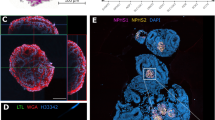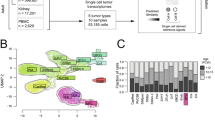Abstract
CONSIDERABLE evidence has been accumulated by Lucké1, Duryee2, Rose3, Tweedell4, and others for an agent which induces an organ-specific adenocar-cinoma in the kidney of the leopard frog, Rana pipiens. Lucké1 has postulated that this agent is probably of a viral nature. Although a percentage of the animals develop palpable renal tumours after a long and variable period of time following injection of tumour material, it is still desirable to devise other methods to propagate and possibly isolate the infective agent. At the same time, the large dimensions of the frog cells make them an ideal system with which to study the initiation of any subcellular modifications following incubation of cells with the tumour-inducing agent.
This is a preview of subscription content, access via your institution
Access options
Subscribe to this journal
Receive 51 print issues and online access
$199.00 per year
only $3.90 per issue
Buy this article
- Purchase on SpringerLink
- Instant access to full article PDF
Prices may be subject to local taxes which are calculated during checkout
Similar content being viewed by others
References
Lucké, B., J. Exp. Med., 68, 457 (1938); Ann. N.Y. Acad. Sci., 54, 1093 (1952).
Duryee, W. R., Ann. N.Y. Acad. Sci., 63, 1280 (1956).
Rose, S. M., Ann. N.Y. Acad. Sci., 54, 1110 (1952).
Tweedell, K. S., Cancer Res., 15, 410 (1955).
Lucké, B., J. Exp. Med., 70, 269 (1939).
Youngner, J. S., Proc. Soc. Exp. Biol. Med., 85, 202 (1954).
Bodian, D., Virology, 4, 575 (1956).
Author information
Authors and Affiliations
Rights and permissions
About this article
Cite this article
AUCLAIR, W. Cultivation of Monolayer Cultures of Frog Renal Cells. Nature 192, 467–468 (1961). https://doi.org/10.1038/192467a0
Issue date:
DOI: https://doi.org/10.1038/192467a0
This article is cited by
-
Establishment of a cell line (XTC-2) from the South African clawed toad,Xenopus laevis
Experientia (1973)
-
Production of monolayer cultures of amphibian tissues and their use for cultivation of vaccinia and measles viruses
Bulletin of Experimental Biology and Medicine (1964)



